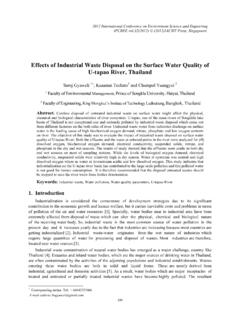Transcription of Phytochemical Analysis and Antibacterial Efficacy of ...
1 Phytochemical Analysis and Antibacterial Efficacy of Babchi Oil (Psoralea corylifolia) Against Multi-drug Resistant Clinical Isolates Sharmishtha Purkayastha and Praveen Dahiya+ Amity Institute of Biotechnology, Amity University, Noida, Uttar Pradesh, India Correspondance: Dr. Praveen Dahiya, Amity Institute of Biotechnology, Amity University, Noida- 201303, Uttar Pradesh, India Abstract. Psoralea corylifolia Linn. (Leguminoseae) known as Babchi is a medicinal plant for the treatment of skin disorders. In the present investigation babchi oil has been evaluated for Phytochemical constituents, Antibacterial activity (agar well diffusion) and TLC bioautography assay. Phytochemical Analysis demonstrated the presence of flavonoids, tannins, steroids, terpenoids, glycosides and saponins. Antibacterial activity of babchi oil was assessed on eight multi-drug resistant (MDR) clinical isolates from both Gram-positive and Gram-negative bacteria and two standard strains.
2 It showed broad Antibacterial activity against both Gram-positive bacteria such as Staphylococcus aureus, S. aureus MRSA, Enterococcus sp. and Gram-negative bacteria Escherichia coli, Pseudomonas aeruginosa, Klebsiella pneumoniae. The highest in vitro inhibitory activity was observed for MDR Enterococcus sp. with wide inhibition zone diameters (21 mm) followed by standard S. aureus ATCC 25923 (16 mm) and K. pneumoniae (15 mm). Thin layer chromatography and bioautography assay demonstrated well-defined growth inhibition zones against Enterococcus sp. in correspondence with tannins observed at Rf values of and This established a good support to the use of this essential oil in herbal medicine and as a base for the development of novel potent drugs and phytomedicine. To the best of our knowledge, this is the first report that documents the Antibacterial Efficacy of tannins found in babchi oil against MDR bacteria from clinical isolates.
3 Keywords: Psolarea corylifolia, agar well diffusion, multi-drug resistant, TLC bioautography 1. Introduction Antimicrobial resistance is a global problem that has created immense clinical problem in treatment of infectious diseases. The clinical Efficacy of many existing antibiotics is being threatened by the emergence of multidrug-resistant (MDR) pathogens. Hospitals, worldwide are major contributors of the problem of antimicrobial resistance [1]. Hospital-acquired infections are expensive to control and extremely difficult to eradicate. In India, antimicrobial resistance has been reported in for the most predominant pathogenic microorganisms including S. aureus, Enterococcus faecalis, Mycobacterium tuberculosis and P. aeruginosa. Medicinal plants form an integral component of research in the pharmaceutical industry focusing on active screenings of natural products to develop better drugs against microbial infections.
4 Psoralea corylifolia Linn. belonging to family Leguminoseae is a well known herb known for its medicinal value in Siddha system of medicines to treat various diseases. Commonly known as babchi, this is an erect annual herb bearing yellow or bluish purple flowers and found throughout Indian plains, Pakistan, Srilanka, Burma and China [2]. Psoralea is one of the main herbs in traditional Indian and Chinese herbal medicine for the treatment of skin disorders. It has been used in the treatment of eczema and hair loss. Roots of the plant are useful in dental caries, fruits are laxative, aphrodisiac, and are used for the treatment of leucoderma, leprosy and in inflammatory diseases of the skin and leaves are good for the treatment of + Praveen Dahiya, Phone: +91-0120-4392195, Fax: +91-0120-2432200 E. mail: 64 IPCBEE 1(2012) (2012)IACSIT Press, Singapoore2012 International Conference on Bioscience, Biochemistry and Bioinformaticsdiarrhea.
5 The plant has been used in Ayurvedic medicinal system as a cardiac tonic, vasodilator and pigmentor. It is widely used in Chinese medicine to treat a variety of diseases and possesses antitumor, Antibacterial , cytotoxic and antihelmenthic properties [3, 4]. Medicinal value of plants lies in the presence of chemical substances that produce a definite physiological action on the human body. The most important bioactive compounds include alkaloids, flavonoids, tannins and phenolic compounds. Thus plants extracts and plant compounds could serve as alternatives in anti-infective therapy of diseases caused by multidrug resistant organisms. Despite possessing wide applicability, babchi has not received much attention and no research on Phytochemical screening and TLC bioautography for babchi oil has been studied till date. The present study relates to Phytochemical screening, Antibacterial activity and TLC bioautography assay against multi-drug resistant (MDR) Gram-positive (Methicillin-resistant Staphylococcus aureus and Enterococcus sp.)
6 And Gram-negative (Klebsiella sp., Escherichia coli, Pseudomonas aeruginosa and Acinetobacter sp.) bacterial strains isolated from human infections. 2. Materials and Methods Acquisition of oil of Psoralea corylifolia Commercial brand of Psoralea corylifolia oil (Babchi oil) was purchased from Delhi, India. As per manufacturer s information, it was prepared by steam distillation. The oil was further distilled by rotary evaporator. Essential oil was dissolved in methanol ( ml oil/ 2 ml methanol). The oil was transferred into sterile vials and stored at 200C until needed. Microbial strain and growth conditions MDR clinical isolates of Staphylococcus aureus, MRSA, Escherichia coli, Kleibsella pneumoniae, Pseudomonas aeruginosa, Enterococcus sp., Acinetobacter sp. and Proteus mirabilis were obtained from the Department of Microbiology, Rajiv Gandhi Cancer Research Institute, Delhi, India.
7 The test strains were maintained on nutrient agar slants (Hi-Media Laboratories Pvt. Limited, Mumbai, India) at 4 C and sub-cultured on to nutrient broth for 24 h prior to testing. These bacteria served as test pathogens for Antibacterial activity assay. Standard strains Staphylococcus aureus ATCC 25923 and Escherichia coli ATCC 25922 were used for quality control. Phytochemical screening Babchi oil dissolved in methanol ( ml oil/2 ml methanol) was evaluated for the presence of different phytochemicals to ascertain the presence of metabolites such as reducing sugars, alkaloids, anthraquinones, glycosides, flavonoids, tannins, steroids, saponins, triterpenoids and phlobatanins by using wet reactions following the procedures described by Sofowora [5] and Trease and Evans [6]. Antibacterial activity assay Antibacterial activity of Psolarea corylifolia oil was determined by agar well diffusion method according to National Commmittee for Clinical Laboratory Standards (NCCLS).
8 About 25 ml of Nutrient agar medium was poured into each petri plate. Once the agar solidified, the bacteria were inoculated on the surface of the plates (1 108 CFU/ml). Subsequently, wells (8 mm in diameter) were punched into the agar medium and filled with 50 l of oil in methanol and allowed to diffuse at room temperature for 2 h. The plates were incubated at 37 C for 24 h. The well containing the same volume of methanol served as negative control while standard antibiotic discs of Imepenem (10 g) and Vancomycin (30 g) were used as the positive controls. After incubation, the diameters of the growth inhibition zones were measured in millimeters. All tests were performed in triplicate and the Antibacterial activity was expressed as the mean of inhibition with their standard deviation. TLC Bioautography assay A thin layer chromatography (TLC) bioautographic agar-overlay method [7] was used to analyze components in babchi oil as well as the most bio-active phytoconstituent (as Antibacterial agent).
9 About 10 l 65of oil in methanol was applied on pre-coated aluminium silica gel G 25 plates. The plates were developed with toluene and ethyl acetate (93:7 v/v). The TLC plates were run in triplicate. One of the strips was visualized under UV light to see if the separated spots were UV active after which it was sprayed with 2% vanillin sulphuric acid reagent, the second strip was used for bioautography assay and the third strip was used to identify spots with the various TLC reagents to detect the presence of flavonoids, saponins and tannins. To detect the presence of flavonoids, plates were sprinkled with a 5% aluminum chloride (AlCl3) ethanolic solution. Yellow or greenish fluorescent spot confirms flavonoids. Saponins were observed by the appearance of blue, violet and yellow spots using 10% vanillin ethanol solution. Tannins were observed by the presence of bluish or greenish black after revelation with a 2% ferric chloride solution.
10 Individual Rf for each spot was measured. TLC bioautography was carried out using the selected strains of bacteria. The developed TLC plates were thinly overlaid with molten nutrient agar inoculated with an overnight culture of bacteria. The plates were incubated in a dark and humid chamber overnight at 37 C. Subsequently, the bioautogram was sprayed with an aqueous solution of 2, 3, 5 triphenyl tetrazolium chloride and further incubated for at 37 C for 4 h. Microbial growth inhibition appeared as clear zones against a pink background. The Rf values of the spots showing inhibition were determined. 3. Results and Discussion Phytochemical Analysis Preliminary Phytochemical screening of babchi oil showed that the essential oil contain most of the phytochemicals (Table 1) including tannins, glycosides, saponins, flavonoids, steroids, terpenoids and flavonosides. However, anthraquinone, phlobatanins and reducing sugars were not observed in babchi oil.









